Oregon, a stunning Pacific Northwest state in the U.S., offers an unbeatable combination of beauty and wildlife for avid hunters. From deer to elk, waterfowl, and upland birds – the diverse range of game species makes it a haven for nature lovers from all over. The hunting seasons are well-regulated by authorities to ensure that populations remain healthy while having an enjoyable experience outdoors.
In this comprehensive guide, we have covered all you need to know about hunting in Oregon. We will discuss species, hunting seasons, license information, and the best places to hunt animals here.
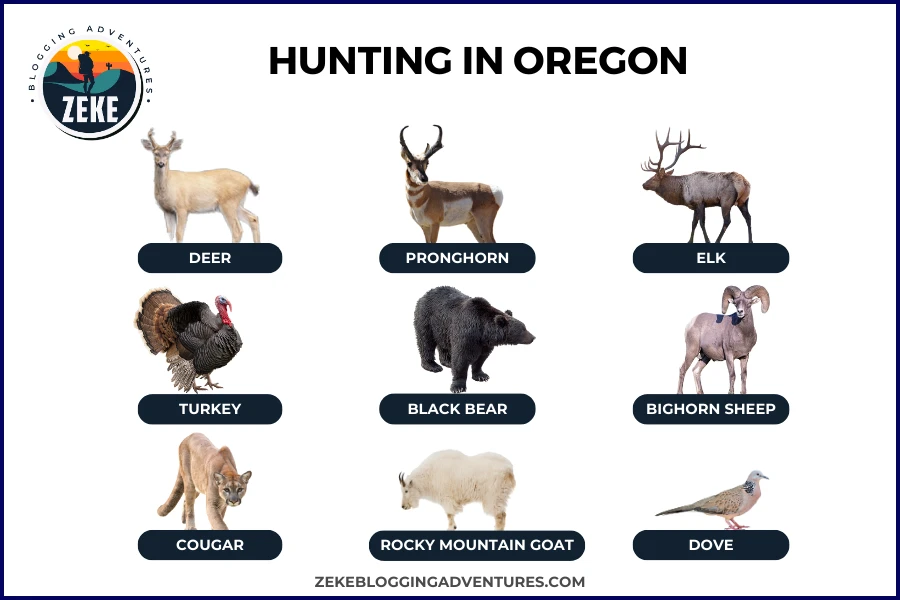
What Can You Hunt in Oregon?
Oregon is known for its abundance of deer, elk, upland birds, and predators like bears, coyotes, and cougars. Mule deer and black-tailed deer are the most common species found here while elk hunting remains a popular sport during their rut season.
Upland birds such as pheasants, quail, grouse, and chukar partridges can be found in open fields or brushy areas while bear hunting demands extra caution due to their agility and strength.
Coyotes, bobcats, foxes, and cougars also roam throughout Oregon’s forests year-round with proper licensing requirements needed before heading out on your hunt. Not to mention the excellent opportunities for waterfowl hunting, including ducks, geese, and swans.
Deer
Oregon boasts diverse deer hunting landscapes. Black-tails inhabit the dense coastal mountains, mule deer roam the open High Desert and northeastern terrains, while the growing white-tail deer population can be found in the southwest and northeast.
White-tailed deer have distinctive long tails and antlers with a single main beam. They share habitats with the mule deer in eastern Oregon. Mule deer, larger than black-tails with forked antlers and mule-like ears, primarily occupy open, rugged terrains. Effective deer hunting techniques include using optics, scent control, and antler rattling.
For detailed season dates, maps, and bag limits, visit the Oregon Department of Fish & Wildlife website.
Buck Deer Season Oregon
| Season | Dates |
| General Season (Any legal Weapon) | Oct 07 – Nov 10 |
| Archery Season (Western Oregon) Units 11, 12, 14, 22, 24, 27, 28 | Sep 02 – Oct 01 |
| Archery Season (Western Oregon) Units 23, 25, 29, 30 | Sep 02 – Oct 01, Nov 18 – Dec 10 |
| Archery Season (Western Oregon) Unit 26 | Sep 02 – Oct 01 |
| Archery Season (Western Oregon) Units 10, 15, 16, 17, 18, 19, 20, 21 | Nov 18 – Dec 10 |
Antlerless Deer Season Oregon
| Season | Dates |
| Any legal Weapon Controlled 600 Series Hunts | Sep 01 – Dec 24 |
| Youth Only Controlled 600 Series Hunts | Aug 01 – Jan 11 |
Elk
Oregon’s elk hold a prestigious second spot, trailing only behind deer in popularity. While the eastern terrains of Oregon are marked by the Rocky Mountain elk, the western side is dominated by Roosevelt elk, with prominent clusters in the Coast, Cascade, and Blue Mountain ranges.
Of the two elk subspecies native to Oregon, the Rocky Mountain elk boasts a population of over 74,000. Notably lighter and a tad smaller than the Roosevelt elk, their antlers take the spotlight, weighing as much as 40 pounds – the heaviest among all elk.
This elk variety predominantly graces eastern Oregon, with a stronger presence in the Blue Mountains and south-central Oregon. Given their inclination for expansive landscapes compared to the Roosevelt elk, hunters should consider techniques like glassing, still hunting, and spot-and-stalk.
With hunting seasons spanning rifles, archery, and muzzleloaders, a plethora of options await. The general season mainly covers archery and specific spike hunts. As the branched bulls of eastern Oregon stand as prized catches, the rifle seasons for them are mostly restricted; remember to apply before May 15th.
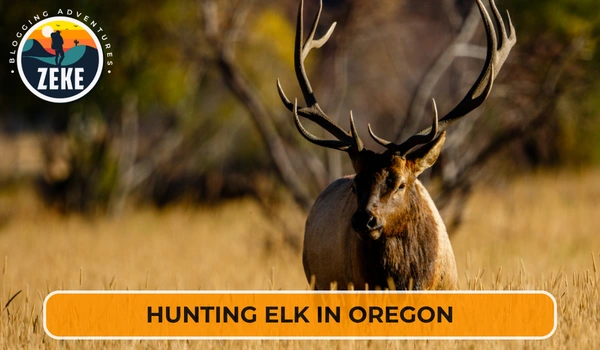
Elk Season
| Season | Dates |
| West Cascade (Any Legal Weapon) | Nov 11 – Nov 17 |
| Rocky Mountain (Any Legal Weapon) | Nov 11 – Nov 29 |
| Coast Bull (Any Legal Weapon) | Nov 18 – Nov 21, Nov 25 – Dec 01 |
| Eastern/Western (Archery) | Sep 02 – Oct 01 |
Black Bear
The vast landscapes of Oregon play host to the black bear, a creature that’s abundant in every corner of the state. Seasons of both spring and fall invite hunters for the pursuit.
Oregon boasts a significant population of around 25,000-30,000 black bears, making them the predominant bear species in North America and the sole bear resident of Oregon. Interestingly, their name can be misleading, as many of these bears sport a brown coat.
These bears have claimed territories across the state, with their densest populations in the Coast and Cascade ranges, as well as the Blue Mountains.
Oregon’s hunting calendar includes a regulated spring season and an open fall season. Early in the spring, scanning open terrains where bears graze on foliage proves effective. As the season progresses, some hunters opt for predator calls to lure them. During the fall, hunters primarily seeking other game, like deer and elk, often hunt many black bears incidentally.
Black Bear Season Oregon
| Season | Dates |
| Black Bear Season (Statewide) | Aug 01 – Dec 31 |
Turkey
Though Oregon wasn’t the original homeland for wild turkeys, a successful introduction in 1961 paved the way for their proliferation. Today, thanks to the transplanting of over 10,000 turkeys, these birds flourish across various parts of the state.
Turkey hunting has blossomed as a favored Oregonian pastime, witnessing a significant surge since the inception of a statewide spring season in 1987. With a generous six-week spring turkey season, The Beaver State stands out as one of the most liberal states for turkey hunting in the U.S. Hunters can target up to three gobblers in spring, and come fall, two birds—with one potentially being from eastern Oregon.
Many enthusiasts prize the spring season as the pinnacle of turkey hunting. This season centers on luring the majestic tom within shooting proximity using a blend of stealth and adept calling.
Though southwestern Oregon is recognized as the prime turkey habitat, their numbers are on the rise in the Willamette Valley, northeastern corner, and the Blue Mountains.
The autumn season has a dual purpose: offering a different hunting experience while mitigating turkey-related disturbances. Hunters can opt for either a hen or a tom. Unlike the spring season, the fall hunt has varied tactics, such as the spot-and-stalk method or dispersing the flock and beckoning them back with calls.
Wild Turkey Season Oregon
| Season | Dates | Bag Limit |
| Spring Turkey | Apr 15 – May 31 | Season Limit: 3 |
| Youth Spring Turkey | Apr 13 – Apr 14, Apr 15 – May 31 | Season Limit: 3 |
| Fall Wild Turkey (WMUs 14-30) | Sep 01 – Jan 31 | Season Limit: 2 |
| Fall Wild Turkey (WMUs 36-38, 40, 43-45, 48 49, 51-65, and 67) | Oct 14 – Nov 30, Dec 01 – Jan 31 | Season Limit: 1 |
| Fall Wild Turkey (WMUs 46-48, 50) | Sep 01 – Nov 30, Dec 01 – Jan 31 | Season Limit: 1 |
Pronghorn
The pronghorn antelope holds the title of North America’s swiftest ungulate, clocking in at astonishing speeds over 50 mph. Around 25,000 of these swift creatures grace Oregon’s landscapes.
Comparable in size to a deer, pronghorns can weigh up to 150 lbs. They possess long, slender legs and unique two-digit feet, devoid of “dew claws”. Their small tail, distinct horns, and vibrant white markings on their flanks, underbelly, and rear make them easily identifiable to hunters.
You’ll find pronghorns roaming the sagebrush expanses of eastern Oregon’s High Desert and the stretches of the Columbia Plateau. Anticipate pronghorn hunting adventures in August, preluding other big game seasons. Prepare for the warmth of the High Desert’s summer.
Securing a pronghorn hunting permit is via a limited entry system (apply by May 15), and patience is key as drawing a tag might require several attempts.
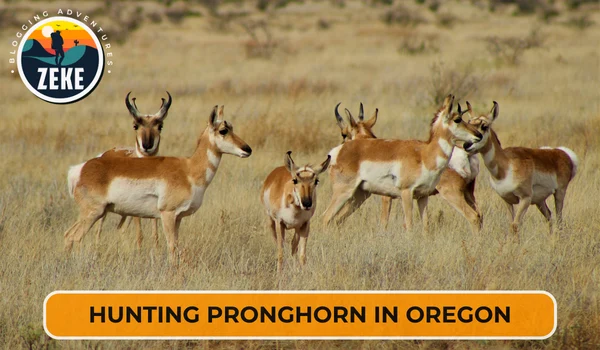
Pronghorn Season
| Season | Dates |
| Any Legal Weapon | Aug 19 – Oct 29 |
| Archery | Aug 10 – Oct 01 |
| Muzzleloader | Aug 30 – Sep 17 |
Bighorn Sheep
Bighorn sheep offer a unique and unparalleled hunting experience in Oregon. There are two types of bighorn sheep found in the state of Oregon.
California Bighorn Sheep: Smaller and sleeker than their Rocky Mountain counterparts, they number around 3,700 and are predominantly found in central and southeast Oregon’s rugged terrains. Annually, only about 100 hunting tags are issued for bighorn sheep, a majority of which are for California bighorns. These tags are a once-in-a-lifetime opportunity.
Rocky Mountain Bighorn Sheep: The larger variant, with a population of roughly 800, is found in northeastern Oregon, especially in the canyons of the Snake River and the Wallowa Mountains. Their presence today is due to reintroduction efforts. The hunting approach for both subspecies requires keen scouting and physical preparation for challenging habitats.
Bighorn Sheep Season
| Season | Dates |
| Bighorn Sheep | Aug 15 – Nov 26 |
Cougar
Often referred to as mountain lions, these majestic felines are Oregon’s largest wildcats. They value solitude, with the exception of mother cougars nurturing their young.
Notably, the male cougars fiercely guard their territories. From a mere 200 in the 1960s, the Beaver State now boasts a robust population of approximately 6,000 cougars.
These elusive creatures have spread their paws across Oregon, particularly marking their presence in the Cascade Range and the Blue Mountains. An uptick in sightings is also observed in the northwest, even reaching the suburbs of the bustling Portland city.
The hunting season for cougars spans the entire year or until the designated zone quotas are fulfilled. Interestingly, many of these cougars are encountered unintentionally by hunters seeking other game like deer and elk. Those, particularly on the lookout for cougars, use predator calls and snowy tracks as cues.
Cougar Season in Oregon
| Season | Dates | Bag Limit |
| Cougar Season | Jan 01 – Dec 31 | 1 Cougar per tag |
Rocky Mountain Goat
The Rocky Mountain goat stands as Oregon’s most uncommon game mammal. Their previous extinction from the state in the 19th century means today’s populations owe their existence to the determined reintroduction endeavors of the ODFW and enthusiast sportsman groups.
These creatures sport black, curved horns, have sizable black hooves, display conspicuous dewclaws, and wear a pristine white, woolly exterior robustly.
These goats favor the challenging steep and rocky terrains of eastern Oregon, making their homes in areas such as the Wallowa, Elkhorn, and Strawberry mountains, as well as the central Cascades near Mt. Jefferson.
Securing a Rocky Mountain goat tag is a rare privilege, with these “once-in-a-lifetime” tags being so limited that fewer than 25 become available annually. Those fortunate to secure a tag must be geared up to navigate their demanding, rugged habitats.
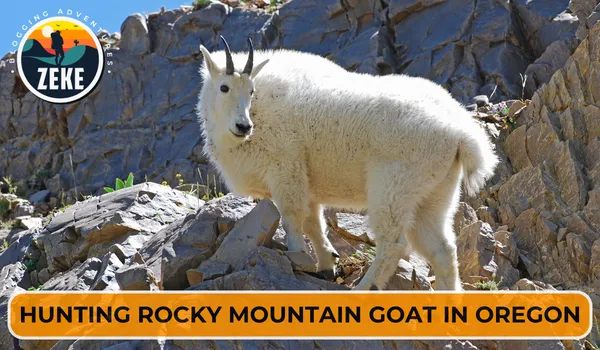
Rocky Mountian Goat Season
| Season | Dates |
| Rocky Mountian Goat (Statewide) | Aug 01 – Oct 31 |
Dove
The bird hunting season in Oregon is inaugurated by the swift and agile mourning dove. These swift migrants offer hunters an exhilarating primer for the seasons ahead.
With their slender frames, extended tails, and petite heads, mourning doves stand out. Their gentle coos coupled with the unique sound of their wings make them instantly recognizable.
Doves often alight on telephone lines or settle in trees. Ground foraging for seeds is a common activity for them. Pre-hunt observation can be invaluable. Keep an eye out for trees or telephone lines proximate to food sources.
Upon spotting a potential location, select a vantage point that effectively camouflages your outline. Settle in and patiently await the opportune moment for a shot. Carrying a few extra shells might come in handy.
Dove Season
| Season | Dates | Bag Limit |
| Zone 01 | Sep 01 – Sep 30, Nov 15 – Dec 14 | 15 per day |
| Zone 02 | Sep 01 – Oct 30 | 15 per day |
Western Gray Squirrel Season
| Season | Dates |
| Specific Areas | Sep 01 – Nov 15 |
| Specific Areas | Sep 15 – Oct 31 |
Bobcat Season
| Species | Dates |
| Bobcat | Sep 01 – Feb 28 |
Raccoon Season
| Species | Dates |
| Raccoon | Sep 01 – Mar 15 |
Fox Season
| Species | Dates |
| Fox | Sep 01 – Feb 28 |
Marten Season
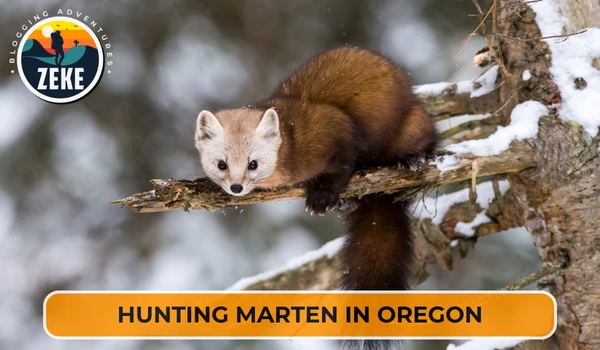
| Species | Dates |
| Marten | Nov 01 – Jan 31 |
Mink Season
| Species | Dates |
| Mink | Nov 01 – Mar 31 |
Muskrat Season
| Species | Dates |
| Muskrat | Nov 01 – Mar 31 |
Otter Season
| Species | Dates |
| River Otter | Nov 15 – Mar 15 |
Beaver Season
| Species | Dates |
| Beaver | Nov 15 – Mar 15 |
Badger Season
| Species | Dates |
| Badger | Jan 01 – Dec 31 |
Nutria Season
| Species | Dates |
| Nutria | Jan 01 – Dec 31 |
Coyote Season
| Species | Dates |
| Coyote | Jan 01 – Dec 31 |
Opossum Season
| Species | Dates |
| Opossum | Jan 01 – Dec 31 |
Porcupine Season
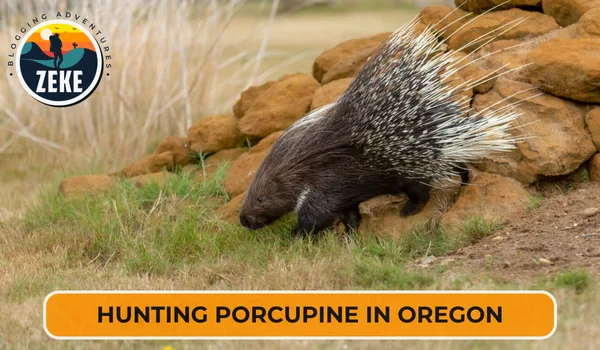
| Species | Dates |
| Porcupine | Jan 01 – Dec 31 |
Skunk Season
| Species | Dates |
| Spotted & Striped Skunk | Jan 01 – Dec 31 |
Weasel Season
| Species | Dates |
| Weasel | Jan 01 – Dec 31 |
Grouse Season
| Species | Dates | Bag Limit |
| Ruffed & Blue Grouse | Sep 01 – Jan 31 | 3 per day (Each Species) |
Chukar Season
| Species | Dates | Bag Limit |
| Chukar & Hungarian Partridge | Oct 14 – Jan 31 | 8 per day |
Pheasant Season
| Species | Dates | Bag Limit |
| Pheasant | Oct 14 – Dec 31 | 2 per day |
Crow Season
| Species | Dates | Bag Limit |
| Crow | Oct 01 – Jan 31 | No Limit |
Band-tailed Pigeon Season
| Species | Dates | Bag Limit |
| Band-tailed Pigeon | Sep 15 – Sep 23 | 2 per day |
Quail Season
| Season | Dates | Bag Limit |
| Western Oregon | Sep 01 – Jan 31 | 10 per day |
| Eastern Oregon | Oct 14 – Jan 31 | 10 per day |
Duck Season
| Zone | Dates | Bag Limit |
| Zone 01 | Oct 14 – Oct 29, Nov 02 – Jan 28 | 7 per day |
| Zone 01 Scuap | Nov 04 – Jan 28 | 7 per day |
| Zone 02 | Oct 14 – Dec 03, Dec 07 – Jan 28 | 7 per day |
| Zone 02 Scuap | Oct 14 – Dec 03, Dec 07 – Jan 10 | 7 per day |
Coot & Merganser Season
| Zone | Dates | Bag Limit |
| Zone 01 | Oct 14 – Oct 29, Nov 02 – Jan 28 | Merganser: 7 Coot: 25 |
| Zone 01 Scuap | Nov 04 – Jan 28 | Merganser: 7 Coot: 25 |
| Zone 02 | Oct 14 – Dec 03, Dec 07 – Jan 28 | Merganser: 7 Coot: 25 |
| Zone 02 Scuap | Oct 14 – Dec 03, Dec 07 – Jan 10 | Merganser: 7 Coot: 25 |
Goose Season
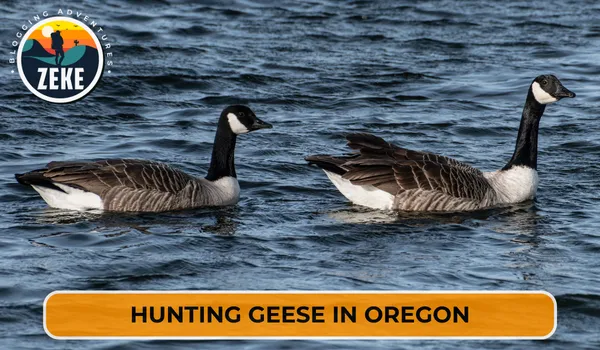
| Season | Dates | Bag Limit |
| Brant Season | Nov 25 – Dec 10 | 2 per day |
| September Canada Goose (Northwest Permit Zone) | Sep 09 – Sep 17 | 5 per day |
| September Canada Goose (Southwest Zone) | Sep 09 – Sep 13 | 5 per day |
| September Canada Goose (High Desert and Blue Mtn Zone) | Sep 09 – Sep 13 | 5 per day |
| September Canada Goose (Mid-Columbia Zone) | Sep 09 – Sep 13 | 5 per day |
| Regular Canada Goose (Northwest Permit Zone) | Oct 21 – Oct 29, Nov 18 – Jan 12, Feb 10 – Mar 10 | 3 per day |
| Regular Canada Goose (Southwest Zone) | Oct 14 – Oct 29, Nov 07 – Jan 28 | 4 per day |
| Regular Canada Goose (South Coast Zone) | Oct 07 – Dec 10, Dec 23 – Jan 14, Feb 24 – Mar 10 | 6 per day |
| Regular Canada Goose (High Desert and Blue Mtn Zone) | Oct 14 – Dec 03, Dec 12 – Jan 28 | 4 per day |
| Regular Canada Goose (Mid-Columbia Zone) | Oct 14 – Oct 29, Nov 07 – Jan 28 | 4 per day |
| White-fronted & White Goose (Northwest Permit Zone) | Oct 21 – Oct 29, Nov 18 – Jan 12, Feb 10 – Mar 10 | 10 White-fronted & 20 White Goose |
| White-fronted & White Goose (Southwest Zone) | Oct 14 – Oct 29, Nov 07 – Jan 28 | 10 White-fronted & 20 White Goose |
| White-fronted & White Goose (South Coast Zone) | Oct 07 – Dec 10, Dec 23 – Jan 14, Feb 24 – Mar 10 | 10 White-fronted & 20 White Goose |
| White-fronted & White Goose (High Desert and Blue Mtn Zone) | Oct 14 – Dec 03, Jan 17 – Mar 10 | 10 White-fronted & 20 White Goose |
| White-fronted & White Goose (Mid-Columbia Zone) | Nov 07 – Jan 28, Feb 03 – Feb 24 | 10 White-fronted & 20 White Goose |
Snipe Season
| Season | Dates | Bag Limit |
| Zone 01 | Nov 04 – Feb 18 | 8 per day |
| Zone 02 | Oct 14 – Jan 28 | 8 per day |
Oregon Hunting License Information
If you’re planning on hunting in Oregon, it’s essential to have the right knowledge about getting your license. For those living in this great state, there are three main types of licenses: the annual hunting license, sports pack license, and combination license.
The annual permit allows access to all game species year-round while the sports pack includes deer tags for bucks and antlerless elk as well as bear tags. Lastly, with a combo license comes both fishing and hunting privileges – giving you full freedom.
Non-residents visiting Oregon for a short time frame can choose between 3 different options; a 3-day non-resident hunt pass (allowing pursuit of any game species), and 7-day or yearly permits which also grant permission for all animals within their designated period.
Before making any purchases, however, hunters born after January 1st, 1974 must complete a hunter education course that covers topics like firearm safety & wildlife conservation – whether online or in person is up to you!
Also, some species may require additional tags such as turkey spring/fall seasons cougars, etc., something extra worth considering before heading out into nature.
You can buy your license either through the Oregon Department of Fish & Wildlife website or at authorized vendors like sporting goods stores and fish/wildlife offices across Oregon.
A hunting license costs $34 for residents and $172 for non-residents in Oregon.
Where Can You Hunt in Oregon?
Oregon provides a diverse range of hunting opportunities suitable for all experience levels. The state boasts extensive public lands managed by the Oregon Department of Fish and Wildlife, covering 2.5 million acres across 50 wildlife management units.
These lands are home to a variety of game species like deer, elk, and bear. For a more challenging hunt, Oregon’s national forests and wilderness areas are available, though they necessitate special permits.
Private land hunts, complete with guided services and accommodations, are also an option, especially for big game hunting. Moreover, the state’s coastal regions and the Columbia River offer prime waterfowl hunting due to their wetlands attracting migratory birds annually.
Public Hunting Places in Oregon
Deschutes National Forest
With over 1.6 million acres of stunning terrain and flourishing wildlife, Deschutes National Forest is an ideal hunting destination for thrill seekers. The Rocky Mountain elk population here provides a unique challenge to hunters – one that could be rewarded with a successful hunt! But if you’re looking for something even more challenging, mule deer are also abundant in this forest. Stalking through the dense woods and bagging a trophy buck will take patience and skill but it’s worth it in the end!
Small game like grouse, quail, and rabbits can also be found throughout Deschutes National Forest – not to mention plenty of waterfowl during the fall season.
No matter what your target species may be, safety should always come first when out hunting in these woods; make sure to familiarize yourself with all rules set forth by the forest service before heading out on your adventure!
Ochoco National Forest
Ochoco National Forest spans over 850,000 acres, offering diverse terrains from desert plains to mountain peaks, making it ideal for hunting species like elk, deer, and bear. The forest provides an abundance of public land with over 500 miles of trails for hunters, and outfitters are available for those seeking guided experiences.
A standout feature of Ochoco is its commitment to conservation and sustainable management, ensuring healthy game populations. Hunters should adhere to state hunting regulations, acquire necessary permits, and prioritize safety by equipping themselves with essential gear and informing someone of their plans.
Umatilla National Forest
At over 1.4 million acres of land, the Umatilla National Forest offers plenty of space for hunters to pursue their passion and test their skills. With a variety of diverse terrain from dense forests to open meadows, each hunt can be an adventure!
The elk population is healthy and abundant in this region which provides the perfect opportunity for successful hunts – but it’s not just big game that draws people here. Smaller animals like pheasants, grouse, or quail roam these woods as well – making bird hunting in autumn air with stunning scenery an unforgettable experience too.
For those looking for more challenge; black bear and cougar hunting can also be found lurking within these vast wilds – requiring skillful tracking and patience if you want any chance at success.
Hells Canyon National Recreation Area
Hells Canyon is a majestic destination situated in the western United States, spanning across parts of Oregon, Idaho, and Washington. The sheer cliffs and deep canyons are home to an abundance of wildlife that makes it perfect for the passionate hunter.
Rocky Mountain elk wander freely through this stunning landscape providing an exciting challenge for hunters looking to take one down. For those seeking something more adventurous, there are bighorn sheep and mountain goats that inhabit some of Hells Canyon’s most remote areas – catching these animals requires grit and determination but the rewards are worth every effort.
Small game opportunities also abound with rabbits, squirrels, and wild turkeys as well as over 200 bird species including pheasants and chukars roaming about making it a paradise for anyone hunting in Oregon.
Private Hunting Places in Oregon
Oregon is a paradise for hunters, offering an amazing range of landscapes and abundant wildlife. For those seeking the ultimate hunting experience, private land provides exclusive access with fewer people competing for the game. Landowners have the flexibility to set their own rules and manage their property specifically for hunting purposes, giving you more chances of success on your hunt.
Before choosing a private place to hunt in Oregon, there are several key factors to consider: permission & permits; location; terrain; game species; and amenities such as lodging or guided hunts available nearby.
Make sure to obtain all necessary licenses and permissions from landowners before heading out – this can be done directly or through leasing agencies. Also, it’s important to choose a spot that’s close enough so you don’t spend too much time traveling pre-hunt!
And finally, decide which type of terrain suits your style best – mountains? Forests? Plains? Research what kind of game species live in each area so you know what potential targets lurk beneath the trees! With these things taken into account, you’ll be well on your way toward finding (and bagging) that perfect trophy!
